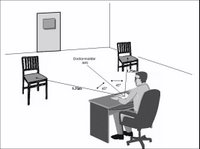 There are at least three different types of reader, with those people who make frequent backward glances to earlier subject headings and key sentences, demonstrating the better comprehension for what they’ve just read. The two other types of reader are slow and fast ‘linear readers’, who tend to read continuously from one line to the next, making few backward glances. The finding comes from an analysis of the eye movements of 44 undergraduate students by Jukka Hyönä and Anna-Mari Nurminen at the University of Turku in Finland, who say their finding has implications for the teaching of reading.
There are at least three different types of reader, with those people who make frequent backward glances to earlier subject headings and key sentences, demonstrating the better comprehension for what they’ve just read. The two other types of reader are slow and fast ‘linear readers’, who tend to read continuously from one line to the next, making few backward glances. The finding comes from an analysis of the eye movements of 44 undergraduate students by Jukka Hyönä and Anna-Mari Nurminen at the University of Turku in Finland, who say their finding has implications for the teaching of reading.“This finding demonstrates the usefulness and functionality of the look-back and rereading fixations”, the researchers said. Jukka Hyönä told the Digest: “Our study clearly shows that the advocates of speed reading are wrong in saying that regressions are a sign of poor reading and a bad habit. We have shown that selective looking back is in fact a sign of strategic reading”.
Hyönä and Nurminen drew their conclusions after recording the students’ eye movements as they read a 12 page on-screen text about animals in danger of extinction. They classified 16 per cent of students as ‘topic structure processors’ who spent more time rereading earlier parts of the current sentence, as well as going back to earlier subject headings and the first sentences of paragraphs. Eighteen per cent of the students were classified as fast linear readers, and 66 per cent as slow linear readers. After reading the text, the students wrote down as many of the main points as they could think of, with the readers who performed more rereading tending to produce a more comprehensive summary of the text.
A later questionnaire showed that the students had good insight into the kind of reader they were, accurately estimating how fast they read compared to other people, and how often they looked back over earlier text.
Jukka Hyona told the Digest “The smart processing strategy that we found could easily be taught to children or adults. In fact, I understand some teachers are actually teaching something similar to our ‘topic structure processing strategy’”.
__________________________________
Hyona, J. & Nurminen, A-M. (2006). Do adult readers know how they read? Evidence from eye movement patterns and verbal reports. British Journal of Psychology, 97, 31-50.
You have read this article Cognition
with the title February 2006. You can bookmark this page URL https://psychiatryfun.blogspot.com/2006/02/against-speed-reading.html. Thanks!
















